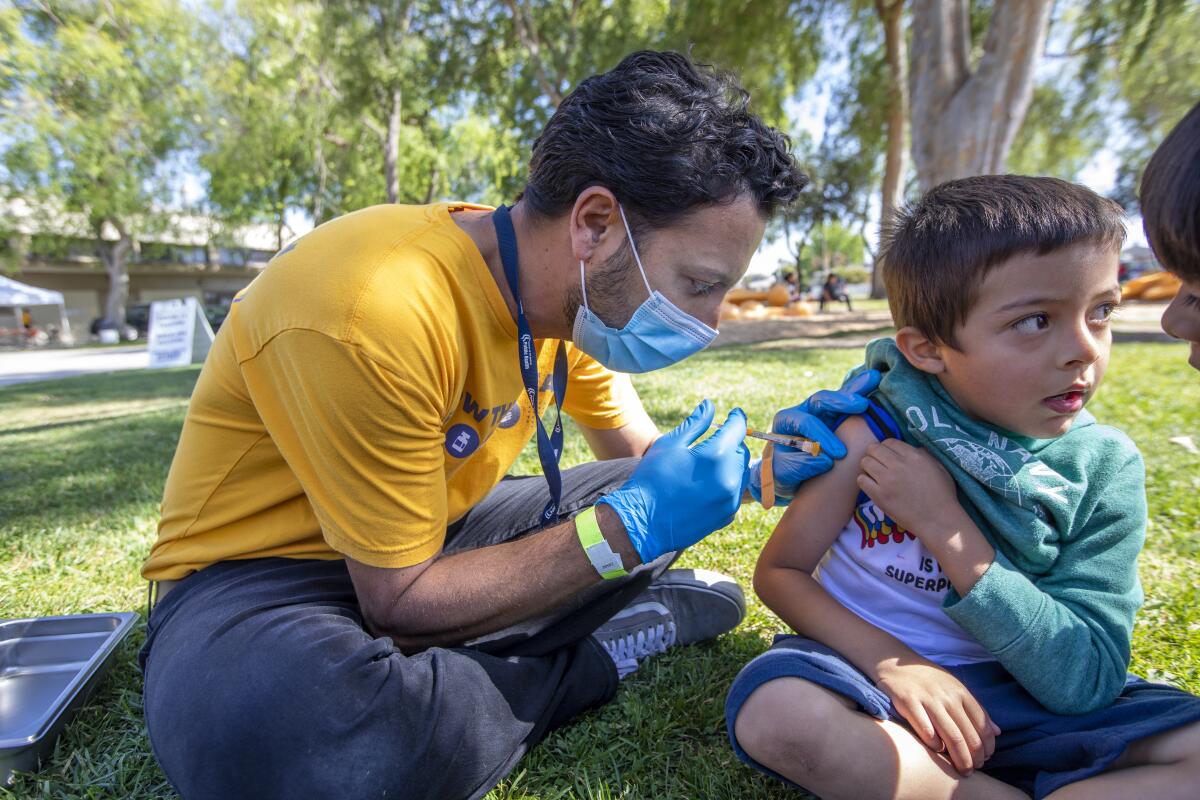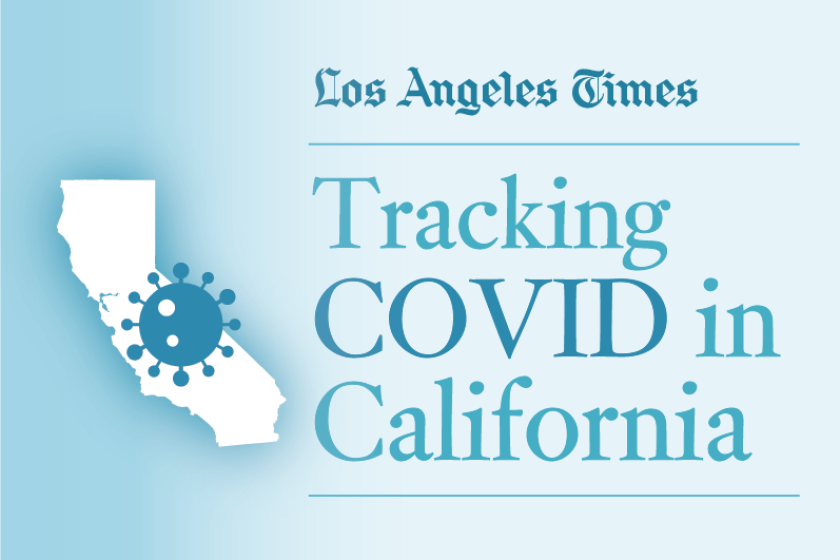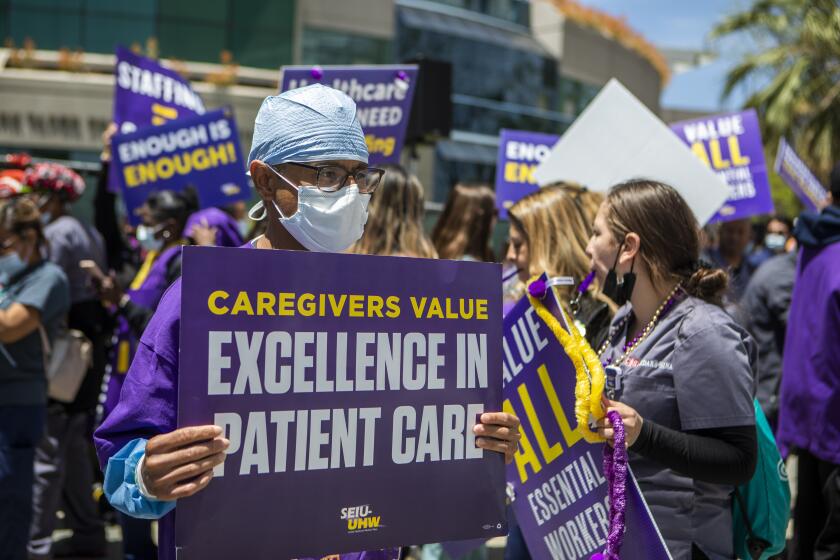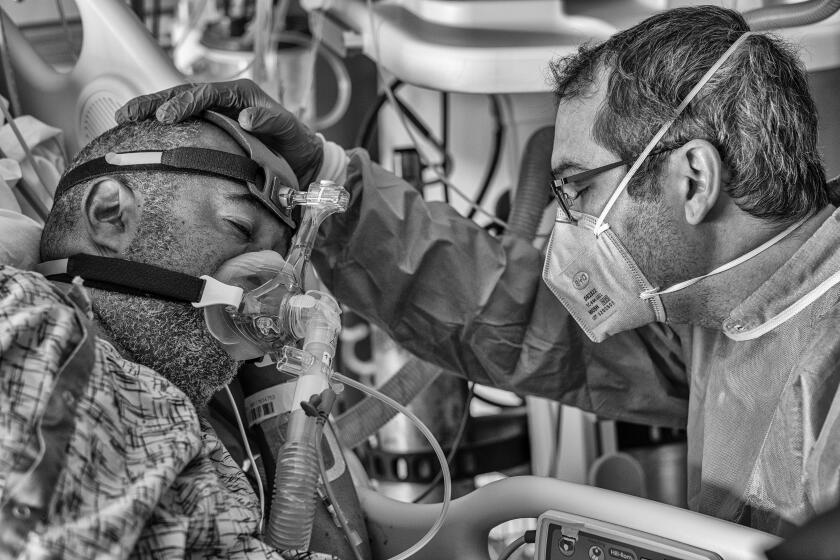With COVID cases rising, how close is California to new mask rules, restrictions?

SAN FRANCISCO — With coronavirus cases continuing to rise in some parts of California, the big question is when some local governments may decide a wave is big enough to intervene with new rules.
The numbers suggest such action is still some ways away, because infection and hospitalization rates are still far from what officials consider the danger zone. While coronavirus-positive hospitalization rates in some parts of California are starting to rise, overall rates remain relatively low.
And it’s unclear whether the pace of new infections will accelerate, remain steady or has actually started to crest and begun to decline. According to state data posted Friday, some parts of California have started to see a slight decrease in cases, although it’s too soon to know whether it’s a blip, a hiccup in the reporting of cases, or the first hint that this wave has reached its peak.
Still, some kind of late spring or summer wave remains possible in California — as has occurred in each of the first two years of the pandemic — and how big one might be this year remains an open question. And that has many experts urging voluntary action — such as mask wearing in indoor public settings — to help prevent bigger problems down the road.
In California, Los Angeles County weeks ago outlined a scenario in which the Department of Public Health would reinstitute a universal mask order in indoor public settings.
While few areas nationwide have reimplemented mask orders recently, rates of cases and hospitalizations have climbed significantly elsewhere in the nation. Places that have met the trigger L.A. County would use to reissue a mask-wearing order include counties that are home to Boston; Detroit; Buffalo, N.Y.; and suburban areas around New York City, such as Long Island and Westchester County.
L.A. County remains far from meeting its own metrics for reissuing a mask order, but a moderate increase in coronavirus case rates has officials concerned. L.A. County has continued to strongly recommend all residents age 2 and over wear masks in indoor public settings — especially higher-quality respirators like KF94, KN95 and N95 masks — ever since it lifted its 7½-month-old universal mask order on March 4.
As of Friday, L.A. County was averaging about 2,800 new coronavirus cases a day over the last week, up 18% over the prior week, or 194 cases a week for every 100,000 residents, according to a Times analysis of county data. The case rate has quadrupled in the last six weeks.
At its current pace, L.A. County is expected to move as early as this week from a low COVID-19 community level, as defined by the U.S. Centers for Disease Control and Prevention and colored green in the agency’s maps, to a medium COVID-19 community level, shaded in yellow. L.A. County will move into the medium COVID-19 community level category once it begins reporting 200 coronavirus cases a week for every 100,000 residents.
A universal mask mandate would return if L.A. County reaches a high COVID-19 community level, colored in orange on the CDC’s maps, health officials have said. The CDC recommends universal indoor masking in counties with a high COVID-19 community level; L.A. County would go a step further and require the face coverings again once that threshold is met.
But L.A. County remains far from that threshold.
One way L.A. County would hit a high COVID-19 community level is if it began reporting a little more than 1,000 new coronavirus-positive hospitalizations every week, or 10 new weekly hospitalizations for every 100,000 residents.
As of Thursday, L.A. County was reporting 315 new coronavirus-positive hospitalizations per week, or 3.1 new hospitalizations a week for every 100,000 residents.
But the rate of new hospitalizations has been increasing at a relatively modest pace. More cautious behavior by Angelenos, and increased vaccination and booster rates, in the meantime, could help slow or reverse the trends.
“COVID-19 is currently not straining our healthcare system and our healthcare resources,” L.A. County Public Health Director Barbara Ferrer said Thursday.
As L.A. County’s coronavirus cases continue to climb, infections are rising fastest among wealthier residents, a likely echo of previous waves in which a greater rate of higher-income people became infected with the virus first.
The pace of new weekly coronavirus-positive hospitalizations has been faster elsewhere. The county home to Boston — Suffolk County — in mid-April began experiencing a more rapid increase in its rate of new coronavirus-positive hospitalizations.
Suffolk County hit the threshold for a high COVID-19 community level on May 5. And as of Thursday, Suffolk County was reporting quadruple L.A. County’s rate of new weekly coronavirus-positive hospitalizations.
No counties in California are in the CDC’s high COVID-19 community level. Nine are in the medium level, the highest number since early March. They are Santa Clara, Alameda, San Francisco, San Mateo, Sonoma, Santa Cruz, Marin, Humboldt and Plumas counties.
Ferrer held out hope L.A. County could avoid getting to a high COVID-19 community level if people took more precautions.
“I think we’ve got a little bit of control over whether that happens or doesn’t by being extra cautious,” Ferrer said. “Nobody should really take lightly their obligation to try not to get infected or to infect others.”
There remain a number of troubling indicators about rising viral transmission in L.A. County. Coronavirus levels in wastewater across wide swaths of the county have nearly doubled in the last two weeks, Ferrer said.
There’s also an ongoing increase in coronavirus transmission at worksites, with 140 sites reporting clusters of coronavirus cases between May 4 to May 10. Many were in food and beverage stores; building material and garden equipment stores; electronic and appliance stores; as well as businesses in the manufacturing, finance and insurance sectors.
The countywide positivity test rate increased to 2.8%. A week ago, it was about 2.2%.
How to process the pandemic death toll? For one hospital chaplain, it means also remembering relatives left behind.
People who have survived an earlier infection with Omicron can’t be assured they won’t get reinfected with another Omicron subvariant, Ferrer said. “It is reasonable to expect that that we’re going to see some reinfections,” Ferrer said.
It’s possible that L.A. County is seeing less of an impact on hospitals compared with parts of the East Coast due to differing dominant strains of the circulating Omicron subvariant. Ferrer said the East Coast is seeing a lot of the subvariant BA.2.12.1, while “we haven’t seen as much of that circulating.”
“So it could be that we have different subvariants that are going to dominate on the East Coast and here in California, and that could create different scenarios,” Ferrer said.
Rising case rates caused health officials across California to issue warnings to reiterate recommendations to wear masks in indoor public settings, from Fresno County, where case rates have doubled recently to nearly 70 cases a week for every 100,000 residents, to the San Francisco Bay Area, which is reporting more than 200 cases a week for every 100,000 residents. A weekly coronavirus case rate of 50 or more is considered substantial, and 100 or more is considered high.
“People are at an elevated risk of contracting COVID-19 right now,” Dr. Susan Philip, the San Francisco health officer, said in a statement. “Wearing a mask in indoor, public settings is a smart move, as is staying up-to-date on vaccinations and, importantly, having a plan to reach a doctor if you get infected.”
Health officials in the Bay Area have not outlined criteria to reestablish a mask mandate.
Hospitalizations are rising in California, but still remain at relatively low levels. As of Saturday, there were 1,378 coronavirus-positive patients in California’s hospitals, up 16% over the prior week. The number of coronavirus-positive patients in intensive care units remains at near-record lows, hovering between about 140 and 180 on any particular day so far this month.
It’s possible that the increase in coronavirus cases may be cresting in parts of the state.
While coronavirus levels in wastewater are increasing in most regions in California, some data suggest they are starting to plateau in Orange County and San Francisco, Dr. Alexander T. Yu, an epidemiologist and infectious-diseases expert with the California Department of Public Health, said in a briefing for the California Medical Assn. last week.
California on Friday reported an average of 7,954 coronavirus cases a day over the last week, or 142 cases a week for every 100,000 residents. That’s up by only 2% over the prior week, whereas for the prior week, there was a 24% week-over-week increase.
L.A. County has been reporting more modest week-over-week increases. L.A. County’s latest weekly increase in its case rate was up by 18%, a more modest rate compared with the prior week, when it climbed by 29%.
San Diego County reported a similar trend, with cases rising by a more modest 17% over the last week, to 162 cases a week for every 100,000 residents. Over the prior week, there was a 39% week-over-week increase in cases.
The San Francisco Bay Area actually reported a 5% decrease in its case rate, falling from 219 cases a week for every 100,000 residents a week ago to 208 cases a week for every 100,000 residents as of Friday.
And Orange County reported a 6% drop, from 97 cases a week for every 100,000 residents to 91 cases a week for every 100,000 residents as of Friday.
There are some potential explanations in L.A. County for why there hasn’t been a commensurate increase in hospitalizations and deaths thus far, even though cases have been increasing here for seven weeks. Daily COVID-19 deaths also remain low and stable in L.A. County, with about four deaths a day.
There might still be a lag between infection and onset of severe illness, although this lag would be much longer than observed previously, Ferrer said. The protective effects of vaccinations, boosters, anti-COVID drugs, and some degree of natural immunity after a previous infection might be helping too.
Another possible explanation, Ferrer said, is that the age demographics of those getting infected recently are not those who are at high risk of severe disease. The age group with the highest coronavirus case rate are those ages 12 to 49, while the case rates are lowest for those ages 80 and older and children under 5.
It remains important that case rates among teenagers and younger adults get reduced, Ferrer said, because they can spread the virus to more vulnerable people.
Ferrer urged people to not think it’s too troublesome or inconvenient to ask people to test themselves before gathering, even if they’re fully vaccinated and have no symptoms of illness.
“One thing we have learned about Omicron is that there are a lot of people that are asymptomatic while they’re infected,” Ferrer said. Having everyone get tested provides more protection for everyone “particularly when you’re going to be indoors, it’s going to be crowded, and you’re going to be with people at higher risk.”
“Don’t feel like it’s an imposition to ask people to test if they’re coming to a gathering,” Ferrer said. “Nobody should ever feel that way.”
The test positivity rate at schools in L.A. County has been increasing, from less than 0.2% in early April to a little less than 0.5% in early May. Still, “while we’ve seen this increase,” the rate indicates “that transmission at schools is relatively low. And we’d like to keep it that way,” Ferrer said.
Taking steps to reduce infection would also reduce the chance of contracting long COVID, where symptoms of illness can persist for months or years, such as chronic problems breathing, feeling exhausted, continued headaches and brain fog.
L.A. County has seen reports of people who had mild COVID-19, recovered, and then fell ill with long COVID symptoms that were more severe than during their initial infection. There are also reports of those who were severely ill with COVID-19 and never felt like they fully recovered, Ferrer said.
More to Read
Sign up for Essential California
The most important California stories and recommendations in your inbox every morning.
You may occasionally receive promotional content from the Los Angeles Times.















